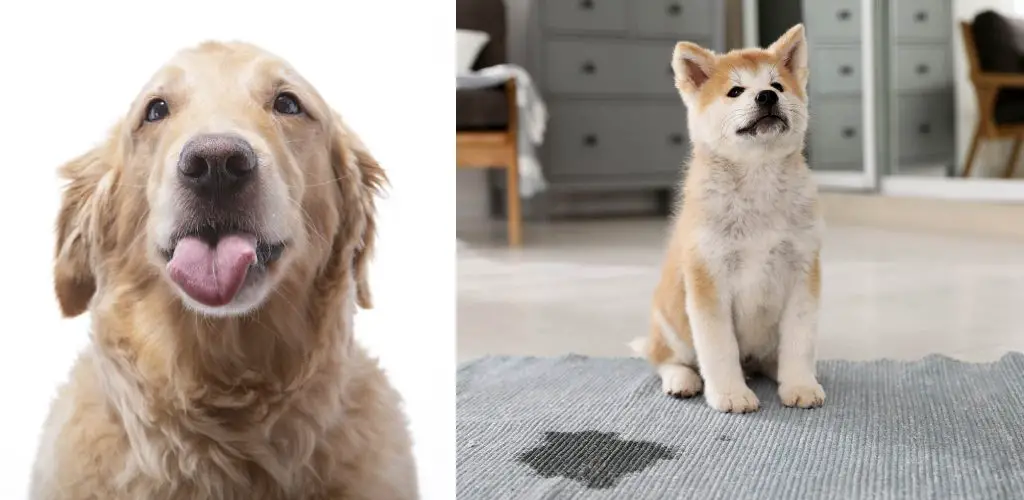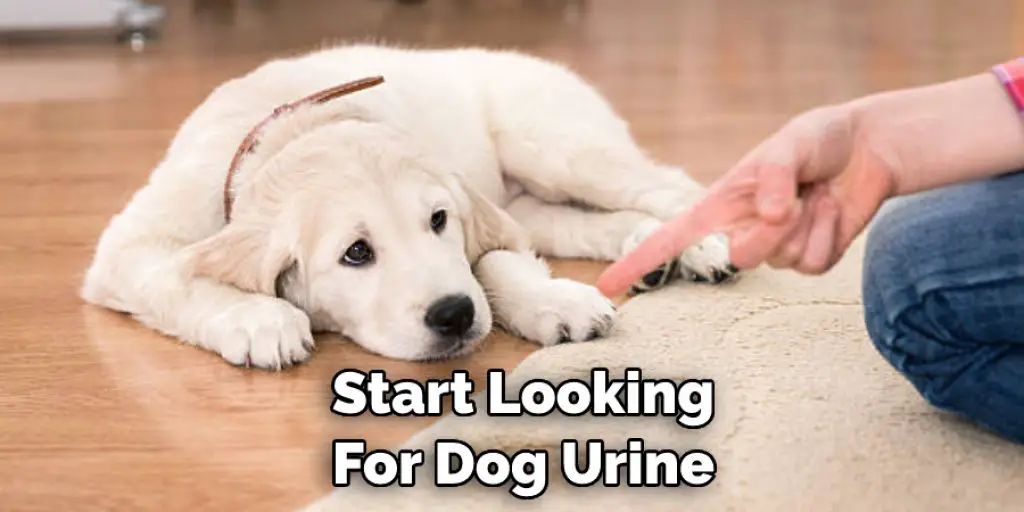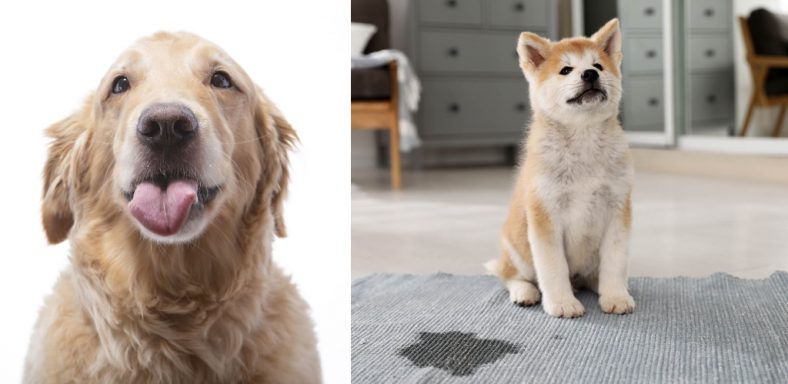We’ve all been there. You walk into a room and suddenly feel a wave of warmth overcome you. It can only mean one thing- your dog has peed again. But where exactly did they go to the bathroom? With no blacklight, it’s impossible to see the urine stain on the carpet.

Luckily, some tips and tricks can help you find those pesky stains without any extra equipment. In this article, we’ll discuss how to find dog urine without a blacklight. Check out our article below!
Many pet parents ask how to find their dog’s urine without a blacklight. After all, traditional methods of finding pet stains involve using a blacklight, which can be challenging. However, if you don’t have a blacklight on hand, don’t worry- there are still ways that you can find those pesky pet stains.
Contents
A Detailed Guide on How to Find Dog Urine Without a Blacklight
Method 1. Use Your Nose
This is the most obvious way to find dog urine, and it can be effective if the pee is fresh. Dogs have a powerful sense of smell, so if there’s any urine around, they’ll be able to sniff it out.
If you think your dog may have peed somewhere in the house, start by taking a good sniff around. See if you can identify any areas that smell particularly strongly of urine. Once you’ve found a likely spot, take a closer look to see if you can see any signs of urine staining.

Method 2. Look for Stains
If you’re unsure where to start looking for dog urine, look for stains. Urine leaves a telltale yellowish-brown stain on surfaces where it comes into contact. You may be able to see these stains even if the area is dry.
To check for stains:
Check for any noticeable stains on your carpets or furniture. If you see any, the chances are that your dog has urinated there.
Use a white towel to blot the area and see if the towel turns yellow or brown. This is another sign that your dog has urinated in that spot.
Look for areas where the carpet or furniture looks damp or smells different from the rest of the room. This could be another sign that your dog has urinated there.
If you can’t find any obvious signs of urine, it’s time to start looking more carefully. Get down on your hands and knees and look for small stains or damp spots.
Once you’ve found a spot that you think might be urine, put a drop of water on it. If the water turns yellow or brown, your dog has likely urinated there.
If you still can’t find any evidence of dog urine, there are a few other things you can try. Dogs often urinate in the same spot repeatedly, so it’s worth checking any spots that your dog likes to hang out in. You can also try using a blacklight to look for invisible stains.
Method 3: Use Peroxide and Baking Soda
If you’re looking for an all-natural way to find dog urine, peroxide and baking soda may do the trick. This method is perfect if you’re concerned about using harsh chemicals around your home.
Here’s What You’ll Need:
- 1 cup of baking soda
- 1 cup of 3% hydrogen peroxide
- A spray bottle
- A cloth or paper towel
Step 1. Before You Start
As with any cleaning project, it’s essential to do a patch test first. To do this, mix a small amount of baking soda and hydrogen peroxide, then apply it to an inconspicuous area of your carpet. Wait 24 hours to see if any staining or damage occurs.
Step 2. Make the Solution
Once you’ve verified that it’s safe to use on your carpet, mix 1 cup of baking soda and 1 cup of 3% hydrogen peroxide in a bowl.
Step 3. Apply the Solution
Pour the solution into a spray bottle, then generously mist the affected areas of your carpet. Let the mixture sit for 5-10 minutes, then blot it with a clean cloth or paper towel.

Step 4. Rinse the Area
After blotting up the solution, rinse the area with clean water to remove any residue. Then, allow the area to dry completely before walking on it or allowing your pets back into the room.
*Repeat this process as necessary until the urine stains are gone.
Method 4: Follow Your Dog
If you have a dog, then finding dog urine is not going to be that difficult. All you have to do is follow your furry friend around and see where they go to relieve him or herself. Once you know where your dog likes to go, put a piece of cardboard or something similar over the area.
Now, wait for your dog to urinate on the cardboard. Once they do, the urine will be absorbed by the cardboard, and you’ll be able to see it. If you can’t see it, use a blacklight to find it.
Once you’ve found the urine, please clean it up immediately using a cleaner designed to remove pet stains. This will help to prevent your dog from urinating in the same spot again.
Method 5: Moisture Probe
If you’re set on using a moisture probe to help you find hidden pet urine, go for it! They can help find small, isolated stains that other methods may have missed. Here’s what you’ll need:

- A moisture probe (available at most hardware stores)
- A pair of rubber gloves
- A dust mask (optional)
Step 1. Prepare the area.
Start by thoroughly vacuuming the area where you think the urine may be. This will help remove any dried urine crystals that interfere with the moisture probe’s readings.
Step 2. Put on Gloves and a Mask (Optional).
While not necessarily required, gloves and a dust mask will help protect you from coming into contact with any bacteria present in the urine.
Step 3. Test the area.
Slowly move the moisture probe across the area in question, paying close attention to the readings. If the readings jump suddenly, there is likely urine present in that spot.
Step 4. Mark the spot (optional).
Once you’ve found an area with a high reading, you may want to mark the spot with a piece of tape or chalk. This will help you remember where it is to clean it more easily later.
Step 5. Repeat as Necessary.
Continue testing the area until you’re confident that you’ve found all the hidden urine stains.
If you follow these steps, you should be able to find most, if not all, of the hidden urine stains in your home. And once you’ve found them, you can start working on getting rid of them!
Method 6. Check Underneath Items
Another excellent hiding place for pet urine is underneath furniture and other items in your home. For example, if you have a piece of furniture that hasn’t been moved in a while, your pet has likely used it as a bathroom.

To check for pet urine, move the item and look for any staining on the floor beneath it. If you see any staining, you can be sure that your pet has urinated there at some point.
If you cannot move the item, you can try using a blacklight to check for pet urine stains. However, remember that blacklights can also pick up other types of stains, so check for other signs of pet urine before assuming that the stain is from urine.
What Smells Deter Dogs Peeing?
Dogs are creatures of habit. If they’ve developed the habit of urinating in your home, it’s because the indoor environment has become attractive to them. Perhaps there’s a spot that’s exceptionally comfortable or convenient, or maybe the scent of their urine is reassuring. Whatever the reason, you’ll need to take action to change your dog’s behavior.
One way to do this is by making the indoor environment less appealing to them. This can be accomplished in several ways, but one of the most effective is using a scent deterrent. Dogs have a keen sense of smell, and certain scents can be very unpleasant. Using a deterrent spray or diffuser can make your home much less appealing to your dog and hopefully break their urge to urinate indoors.
Several different scents can be effective deterrents for dogs. Citrus is often used, as the scent is powerful and unpleasant to dogs. Other popular options include mint, eucalyptus, and lavender. You can experiment with different scents to see which one works best for your dog.
In addition to using a scent deterrent, you’ll also need to clean up any existing urine stains. Even if you can’t see them, your dog will be able to smell them, and they’ll continue to use that spot as a bathroom unless you remove the odor completely. The best way to do this is with an enzymatic cleaner, which will break down the urine and remove the odor.
With some effort, you should be able to break your dog’s habit of urinating indoors. By using a combination of deterrents and cleaners, you can make your home much less appealing to them, and eventually, they’ll learn to hold it until they can go outside.
Conclusion
If you’re having trouble finding dog urine, don’t worry – there are a few methods you can use to help locate the spot. First, try using a blacklight. If that doesn’t work, consider using an enzyme cleaner or making your DIY cleaner. With a little effort, you should be able to find and clean up any dog urine messes. We hope you find this article on how to find dog urine without a blacklight helpful.

